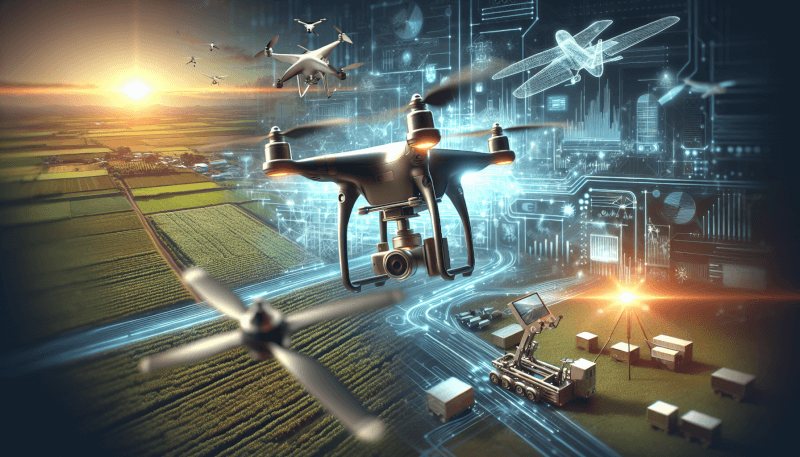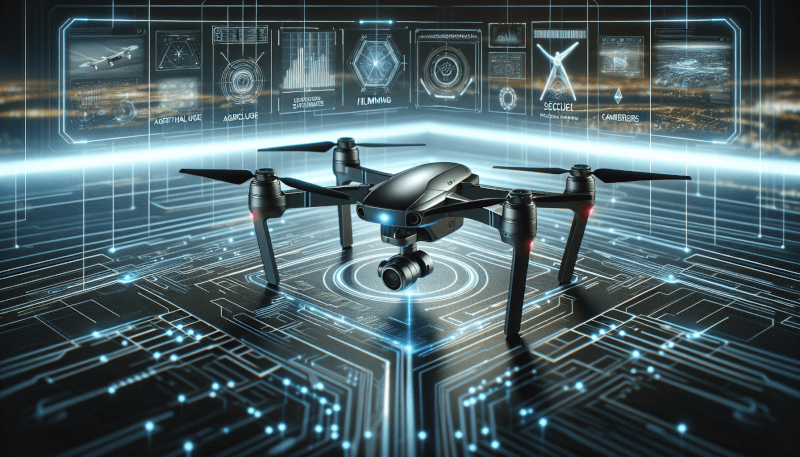Imagine soaring through the sky with the latest drone technology innovations at your fingertips! From enhanced flight capabilities to cutting-edge camera features, these advancements are revolutionizing the way we capture stunning aerial footage. Get ready to discover the extraordinary world of drones and embrace a whole new perspective on adventure and creativity. Let’s explore how these technological wonders are transforming the way we see the world from above.

Autonomous Drones
Autonomous drones are revolutionizing the unmanned aerial vehicle (UAV) industry through their advanced capabilities. These drones are equipped with cutting-edge artificial intelligence (AI) integration, allowing them to perform complex tasks without the need for constant human control. With AI, drones can make decisions on their own, adapt to changing environments, and even learn from their experiences.
1.1 Artificial Intelligence (AI) Integration
Artificial intelligence (AI) integration is at the forefront of autonomous drone technology. With AI algorithms, drones can analyze data in real-time, make intelligent decisions, and execute tasks with precision. This technology allows drones to navigate through obstacles, choose optimal flight paths, and adjust their flight patterns based on environmental conditions.
1.2 Advanced Navigation Systems
Autonomous drones rely on advanced navigation systems to navigate accurately and safely. These navigation systems incorporate GPS technology, enabling drones to determine their position in real-time. Additionally, drones may use sensors like accelerometers and gyroscopes to maintain stability during flight. With these advanced navigation systems, drones can fly autonomously and reach their destinations efficiently.
1.3 Collision Avoidance Technology
One of the key features of autonomous drones is their ability to avoid collisions. Collision avoidance technology uses sensors, such as proximity sensors and cameras, to detect obstacles in the drone’s path. When an obstacle is detected, the drone adjusts its flight trajectory or altitude to avoid a collision. This technology ensures safe and efficient drone operations, minimizing the risk of accidents and damage.
Payload and Camera Innovations
Payload and camera innovations have significantly improved the capabilities of drones in various industries. These innovations have led to the development of high-resolution cameras, thermal imaging cameras, and LiDAR technology for enhanced data collection and analysis.
2.1 High-Resolution Cameras
High-resolution cameras allow drones to capture detailed images and videos from the sky. These cameras offer superior image quality, enabling professionals in fields such as photography, cinematography, and surveillance to obtain stunning visuals and valuable insights. With high-resolution cameras, drones can gather accurate and high-quality data for a wide range of applications.
2.2 Thermal Imaging Cameras
Thermal imaging cameras bring a new level of functionality to drones. These cameras can detect heat signatures, allowing drones to identify objects and individuals that are not visible to the naked eye. Thermal imaging cameras have invaluable applications in search and rescue operations, wildlife monitoring, and infrastructure inspections, where thermal anomalies can indicate potential issues or hazards.
2.3 LiDAR Technology
LiDAR (Light Detection and Ranging) technology is being increasingly integrated into drones for precise mapping and 3D modeling. LiDAR sensors emit laser pulses that bounce back when they hit objects, creating highly accurate depth maps. This technology enables drones to generate detailed topographic maps, measure distances with precision, and even create 3D models of buildings and landscapes. LiDAR-equipped drones are proving to be invaluable tools in fields like urban planning, construction, and archaeology.

Battery Technology Advancements
Battery technology advancements have been pivotal in improving the flight capabilities and longevity of drones. With longer flight times, intelligent battery management, and fast charging solutions, drones can operate for extended periods, enhancing their usefulness and efficiency.
3.1 Longer Flight Times
One of the primary challenges for drone technology has been the limited flight time due to battery constraints. However, recent advancements in battery technology have extended the flight times of drones significantly. Drones can now stay airborne for longer periods, enabling them to cover a larger area, perform more tasks, and gather more data without frequent battery replacements.
3.2 Intelligent Battery Management
Intelligent battery management systems have emerged to optimize the performance and lifespan of drone batteries. These systems monitor battery health, regulate power usage, and provide real-time feedback to drone operators. By optimizing battery usage and preventing over-discharge or overcharging, intelligent battery management systems ensure the longevity and reliability of drone operations.
3.3 Fast Charging Solutions
Fast charging solutions have been developed to minimize downtime and maximize drone productivity. With quick charging capabilities, drone operators can rapidly recharge their batteries, reducing the waiting time between flights. This is particularly beneficial in time-sensitive missions or scenarios where drones need to cover a large area in a short period.
Drone Swarms
Drone swarms are groups of drones that work together in a coordinated manner, leveraging collective decision making, enhanced communication systems, and synchronized movements. These swarms offer unique advantages in various applications, including search and rescue, surveillance, and even entertainment.
4.1 Collective Decision Making
In a drone swarm, individual drones communicate and make decisions collectively. By sharing information, analyzing data, and coordinating their actions, drone swarms can accomplish complex tasks with increased speed and efficiency. Collective decision making enables swarms to adapt to dynamic environments, allocate resources optimally, and respond effectively to changing scenarios.
4.2 Enhanced Communication Systems
To facilitate collective decision making, drone swarms utilize advanced communication systems. These systems enable seamless communication between drones, allowing them to share information, exchange commands, and maintain situational awareness. Enhanced communication systems ensure that every drone in the swarm is aware of the overall mission objectives and can collaborate effectively.
4.3 Synchronized Movements
Synchronized movements are a hallmark of drone swarms. By following predetermined flight paths and adhering to predefined formations, drones in a swarm can achieve remarkable visual displays and perform intricate maneuvers. Synchronized movements require precise coordination and control, enhancing the aesthetic appeal of drone displays and enabling synchronized actions in various applications.

Sense and Avoid Systems
Sense and avoid systems are crucial for ensuring the safety and reliability of drone operations. These systems employ radar sensors, vision-based obstacle detection, and machine learning algorithms to detect and avoid obstacles during flight.
5.1 Radar Sensors
Radar sensors are commonly used in sense and avoid systems to detect objects in the environment. These sensors emit radio waves and analyze the signals bounced back from surrounding objects to determine their distance and direction. By continuously monitoring the surroundings, radar sensors alert drones of potential collisions and enable them to adjust their flight path accordingly.
5.2 Vision-based Obstacle Detection
Vision-based obstacle detection utilizes cameras and computer vision algorithms to detect obstacles during flight. These systems analyze images or video feed in real-time, identifying objects that may pose a risk to the drone’s safety. Vision-based obstacle detection is particularly effective in scenarios where radar sensors may not provide sufficient coverage, such as in urban environments with complex structures.
5.3 Machine Learning Algorithms
Machine learning algorithms play a vital role in sense and avoid systems by enabling drones to learn and adapt to their surroundings. These algorithms analyze sensor data, identify patterns, and build models to predict potential obstacles and hazards. Over time, drones equipped with machine learning algorithms can improve their obstacle detection capabilities and make informed decisions to avoid collisions.
Drones for Medical Deliveries
Drones are increasingly being used for medical deliveries, offering fast and efficient transportation of critical supplies in various situations. From blood and organ transportation to emergency medical supplies and remote area support, drones are revolutionizing the healthcare industry.
6.1 Blood and Organ Transportation
Transporting blood and organs for transplantation is a time-sensitive and high-stakes process. Drones equipped with specialized containers and temperature-controlled compartments can ensure the safe and rapid delivery of blood samples and organs between medical facilities. These drones can navigate congested areas and bypass ground transportation limitations, saving valuable time and potentially saving lives.
6.2 Emergency Medical Supplies
In emergency situations, immediate access to medical supplies can be crucial for saving lives. Drones equipped with medical supply kits can quickly deliver essential equipment, medications, and first aid materials to remote or hard-to-reach areas. These drones can bypass road congestion, rough terrain, or natural disasters, providing swift medical support when time is of the essence.
6.3 Remote Area Medical Support
Drones have the potential to revolutionize medical support in remote areas where traditional transportation methods are limited or non-existent. Equipped with advanced medical equipment, these drones can offer telemedicine services, collect diagnostic data, and deliver medical advice to individuals in remote locations. Remote area medical support by drones can bridge the healthcare gap, providing essential medical assistance to underserved communities.

Advanced Flight Control Systems
Advanced flight control systems have greatly enhanced the maneuverability, precision, and safety of drones. With GPS positioning, precision hovering, and waypoint navigation, drones can perform complex flight operations with ease.
7.1 GPS Positioning
GPS positioning is integral to the flight control systems of drones. By leveraging GPS signals, drones can determine their exact position, altitude, and orientation in real-time. GPS positioning enables accurate navigation, geolocation, and automated flight modes, such as follow-me or return-to-home functions. It ensures that drones can operate reliably and reach their intended destinations with precision.
7.2 Precision Hovering
Precision hovering is a critical feature for drones that require stable flight control, such as aerial photography, inspections, or surveying. By utilizing sensors and advanced algorithms, drones can maintain their position and altitude with great accuracy, even in windy conditions. Precision hovering allows drones to capture steady and smooth footage, perform intricate tasks, and conduct precise inspections.
7.3 Waypoint Navigation
Waypoint navigation enables drones to follow predefined flight paths automatically. By setting waypoints on a map or using GPS coordinates, operators can program a series of specific locations for the drone to navigate. Waypoint navigation is particularly useful for large-scale operations, aerial surveys, or surveillance missions where drones need to cover extensive areas efficiently. It reduces the reliance on manual control and ensures consistent and accurate flight paths.
Foldable and Portable Drones
Foldable and portable drones offer convenience and ease of transportation, making them ideal for travelers, outdoor enthusiasts, and professionals on the go. With collapsible designs, easy carrying cases, and quick assembly features, these drones are compact and user-friendly.
8.1 Collapsible Designs
Collapsible designs allow drones to fold into a compact form factor, making them easy to transport and store. These drones feature hinged arms or flexible frames that can be folded and locked into place when not in use. Collapsible designs are particularly convenient for travelers or backpackers who need to carry their drones in compact spaces.
8.2 Easy Carrying Cases
Easy carrying cases provide protective storage solutions for portable drones. These cases are designed to securely hold the folded drone, along with its accessories and spare parts. Carrying cases often feature durable materials, foam padding, and custom compartments to ensure the safety of the drone during transportation. They allow users to quickly pack and carry their drones wherever they go.
8.3 Quick Assembly
Quick assembly is a key feature for foldable and portable drones. These drones are designed with user-friendly mechanisms that allow for easy and fast assembly. With intuitive connectors, snap-on components, or magnetic attachments, users can assemble their drones within minutes, eliminating the need for complex setup procedures. Quick assembly is ideal for outdoor enthusiasts who want to capture spontaneous moments or professionals who require swift deployment of their drones.

Drone Racing Innovations
Drone racing has gained immense popularity as a thrilling and competitive sport. Innovations in FPV technology, high-speed racing drones, and virtual reality integration have propelled drone racing to new heights, offering an exhilarating experience for pilots and spectators alike.
9.1 FPV (First Person View) Technology
FPV technology allows drone racers to experience the excitement of high-speed flight from the drone’s perspective. Pilots wear FPV goggles or use a monitor to view the live video feed transmitted from the drone’s onboard camera. This immersive experience provides a thrilling sensation, as pilots navigate through challenging race courses at incredible speeds.
9.2 High-Speed Racing Drones
High-speed racing drones are specifically designed for agility and speed. These drones feature lightweight frames, powerful motors, and aerodynamic designs, allowing them to reach blistering speeds and maneuver through tight spaces with precision. Racing drones often incorporate advanced flight control systems and specialized racing propellers to maximize their performance on the race track.
9.3 Virtual Reality Integration
Virtual reality (VR) integration adds an extra layer of immersion to drone racing. Spectators can use VR headsets to experience the race from different camera angles, switching between drones in real-time. This technology allows viewers to feel as if they are amidst the action, enhancing the spectator experience and bringing drone racing to life in a whole new way.
Drone Delivery Services
Drone delivery services have the potential to revolutionize the logistics industry, offering efficient and timely deliveries in various contexts. With advancements in last-mile deliveries, regulatory frameworks, and urban air mobility, drones are reshaping the future of delivery services.
10.1 Last-Mile Deliveries
Last-mile deliveries refer to the final leg of the delivery process, where goods are transported from a distribution center to the recipient’s doorstep. Drones are well-suited for last-mile deliveries as they can bypass traffic and navigate directly to the delivery location. By leveraging advanced navigation systems and AI algorithms, drones can deliver packages quickly and efficiently, reducing delivery times and improving customer satisfaction.
10.2 Regulatory Frameworks
To ensure the safe integration of drones into the airspace, regulatory frameworks are being established worldwide. These frameworks set standards and guidelines for drone operations, including delivery services. They address issues such as flight restrictions, altitude limitations, pilot licensing, and privacy concerns. By implementing clear and robust regulatory frameworks, governments can facilitate the integration of drones into existing delivery systems while maintaining safety and security.
10.3 Urban Air Mobility
Urban air mobility refers to the use of drones and other aerial vehicles for transportation within urban areas. With the rise of congested cities and increasing demand for efficient transportation solutions, urban air mobility presents a promising future for drone delivery services. By utilizing dedicated air corridors, landing zones, and vertical take-off and landing capabilities, drones can navigate urban environments and transport goods quickly and safely, easing the burden on ground-based logistics systems.
In conclusion, the latest drone technology innovations have transformed the capabilities and potential applications of unmanned aerial vehicles. From autonomous drones with AI integration and advanced navigation systems to payload and camera innovations, the possibilities for data collection and analysis have expanded significantly. Battery technology advancements have extended flight times and improved efficiency, while sense and avoid systems have enhanced safety and reliability. Drones are now being utilized in medical deliveries, offering fast and efficient transportation of critical supplies. Advanced flight control systems and foldable/portable designs have made drones more versatile and user-friendly. The emergence of drone racing as a thrilling sport has pushed technological advancements in FPV technology and high-speed racing drones. Lastly, drone delivery services are poised to revolutionize last-mile deliveries, supported by regulatory frameworks and the concept of urban air mobility. With these innovations, drones are reshaping industries and paving the way for a future where aerial operations become an integral part of everyday life.


